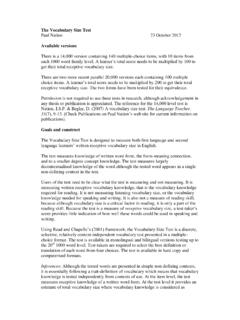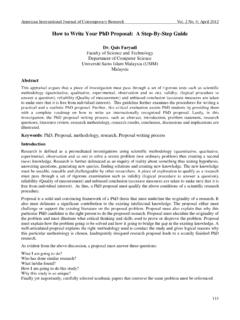Transcription of Please note: This is a sample PhD thesis proposal for the ...
1 Doctoral thesis research proposal (2010) 1 of 18 Please note: This is a sample PhD thesis proposal for the School ofGeography Environment and EarthSciences at Victoria University. It may be used by PhD students as an example ofthe length and format of a past, accepted proposal , but it should not be copied or used as atemplate forother PhD thesis proposals. Using glacier models toreconstruct climate change over the last 13,000 years proposal for thesis March, 2010 Ph. D. Candidate (Geology) My Name, Student Number: 0000000000 School of Geography, Environment and Earth Sciences, Victoria University of Wellington Ph. D. Supervisors Ben Glacier, Victoria University of Wellington Jerry Moraine, Victoria University of WellingtonDoctoral thesis research proposal (2010) 2 of 18 I.
2 ABSTRACT Instrumental weather data in New Zealand extend back to about 1860 AD, leaving great uncertainties about longer term natural climate variability. Glaciers exhibit one of the clearest and most direct responses to climate change and past glacier extents afford an opportunity to decipher paleoclimate. Now that the accuracy and precision of moraine chronologies has improved through advances in surface exposure dating (SED) techniques, multi proxy and global climate comparisons have become more refined. Interhemispheric climate event relationships are valuable when looking for causes or triggers of climate change however, the interpreted temperature changes from glacier fluctuations are generally qualitative rather than quantitative.
3 Here we use numerical modelling as a tool to quantify paleoclimate fluctuations with a combination of mapped moraine positions, surface exposure dating chronologies, and modern and proxy climate data for model construction and tuning. We will evaluate the effects that precipitation, temperature, and solar radiation have on glaciers through empirical field evidence and numerical modelling from four sites distributed throughout the Southern Alps of New Zealand. This approach will allow us to constrain an envelope of possible climatic conditions necessary for the glacier to advance and stabilise at specified lengths. Detailed moraine chronologies now exist at three of these sites and a multiple year glacier mass balance study exists at the fourth site.
4 The modelling results have the potential to help us better understand (1) the regionality and seasonality of past climate change within New Zealand, (2) what climatic signals the glaciers are responding to, and (3) interhemispheric differences in glacier extent, such as why the "Little Ice Age" in New Zealand was such a minor event compared to others during the Holocene. II. TOPIC DEVELOPMENT A) Background Recent technological advances in surface exposure dating (SED) methods have allowed for more precise moraine chronologies than previously possible (Putnam et al., in press Putnam et al., in prep Schaefer et al., 2009). These chronologies offer the unique opportunity for paleoclimate reconstructions with highly accurate ages. Previous paleoclimate investigations of these moraines focused on geometric reconstructions assuming an accumulation area ratio (AAR) of (Chinn, 2006 Kaplan et al.
5 , submitted Putnam et al., in prep) and resulted in equilibrium line altitude (ELA) depression estimates (Porter, 1975). Although these are reasonable estimates, they can only represent a snapshot or steady state reconstruction and cannot account for the time dependent evolution of glacier length. Moreover, they do not account for valley specific topography, shading, local mass balance, or glacier response time (Oerlemans, 2005). Here we implement numerical glacier models, based on the physics of glacier dynamics and modern climate data to interpret paleoclimate from these moraine ages and positions. This proposal focuses on four paleo glaciers, each different in catchment size, valleytopography, andlocal mass balance. The paleoclimate history of New Zealand, as expressed by moraine chronologies and marine and tarn sediment cores since the Last Glacial Interglacial Transition (LGIT), differs from records in the Northern Hemisphere (Schaefer et al.
6 , 2009 Vandergoes et al., 2003 Vandergoes et al., 2008 Newnham and Lowe, 2000 Newnham and Lowe, 2003). Glacier retreat from the last full glacial to today was interrupted by a series of short lived stagnations resulting in moraine sequences in certain valleys in central South Island, New Zealand (Andersen et al., in prep). Fortunately, unlike in the European Alps, glaciers retreated steadily during the Holocene in New Zealand and the Little Ice Age (LIA) event was relatively minor and the glaciers did not override and destroy earlier Holocene moraines. Likewise, New Zealand glaciers retreated steadily during the Younger Dryas Chron whenDoctoral thesis research proposal (2010) 3 of 18 European Alps glaciers readvanced (Kaplan et al.
7 , submitted). This climate asynchrony between the Northern and Southern Hemispheres has been attributed to the bipolar seesaw, atmospheric CO2, and regional climate feedbacks (Broecker, 1998 Kaplan et al., submitted Putnam et al., in prep Schaefer et al., 2009). It is essential to test what the New Zealand temperate, maritime glaciers are responding to, be it temperature, precipitation, or nonclimatic factors. Rother and Shulmeister (2005) suggest that increased accumulation due to synoptic climate change can be the sole cause of glacier advances in high precipitation regions. Roe (in prep) suggests that glaciers in maritime climates are subject to a high degree of precipitation variability and therefore have muted sensitivity to temperature.
8 In contrast, Oerlemans (2001) states that glaciers in wetter climates exhibit increased sensitivity due to a stronger albedo feedback, a larger effect on the partitioning of precipitation between snow and rain, and a longer ablation season because glaciers extend farther down in elevation. Based on the New Zealand End of Summer Snowline Survey (EOSS), ELA values of individual glaciers are highly co related to the mean ELA , demonstrating a single climate zone influence (Chinn et al., 2006). That is to say, whatever New Zealand glaciers are responding to, they are doing so together, across the Southern Alps and across precipitation gradients. B) Previous Work and Geologic Setting Oerlemans (2005), Oerlemans and Hoogendoorn (1989), and Plummer and Phillips (2003) emphasised several reasons why numerical models of ice for paleoclimate reconstructions are more desirable than other methods.
9 By including features such as aspect, slope, bed topography, local climate and overhead insolation, these models have the potential to produce more accurate climate histories than AAR / ELA calculations. For example, Anderson and Mackintosh (2006b) used a glaciological model based onthe physics of glaciers and validated against field evidence from Franz Josef Glacier. They adjusted temperature and precipitation independently in the model to drive the glacier out to the Waiho Loop moraine. The test showed that either a C drop in mean annual temperature, 400% increase in mean annual precipitation, or some combination of the two would be necessary for the glacier to advance 10 km down valley from its modern position (Anderson and Mackintosh, 2006b).
10 Recent efforts to date New Zealand moraines, led by the Denton (University of Maine) group, have focused on the best preserved, most complete moraine sequences (Putnam et al., in prep Kaplan et al., submitted Schaefer et al., 2009). To accompany the SED ages, the digitised Central South Island Glacial Geomorphology (CSIGG) map assembled by Andersen et al. (in prep) includes detailed moraine positions and other geomorphic interpretations. These maps have been on display at several paleoclimate conferences and preliminary examples are available online (Andersen et al., in prep). Most of the glacier systems chosen for the modelling project are included in the CSIGG map coverage (Barrell and Suggate, in prep). Detailed Holocene moraine chronologies exist for Hooker, Mueller and Tasman glaciers (Schaefer et al.)


















